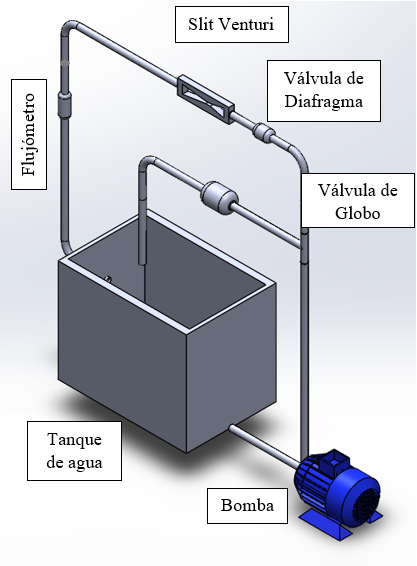Medición experimental de la densidad de la nube de cavitación en un Slit Venturi
DOI:
https://doi.org/10.37636/recit.v5n4e231Palabras clave:
Venturi, Cavitación, Número de Thoma, Coeficiente de cavitación, Número de ReynoldsResumen
En el presente trabajo, se reporta la caracterización experimental de la formación y desarrollo de la nube de cavitación en diferentes temperaturas de líquido 20, 30, 40 y 50 °C. Para ello, se construyó una instalación hidráulica que tiene como elemento principal un tubo Venturi de sección rectangular, con ella, se generaron las condiciones de flujo necesarias para formar la cavitación y medir las propiedades termodinámicas para el cálculo de los números adimensionales de Thoma y Reynolds. El error promedio de sesgo de las mediciones no superó el 1%, por tal razón, se aseguró la buena calidad del cálculo en los números adimensionales de Thoma y Reynolds. Con los números de Thoma “σ” y Re se caracterizaron las diferentes fases de la nube de cavitación, desde incipiente, cuasi, desarrollada y super cavitación en el rango de temperaturas del experimento, encontrando que el tránsito de la cavitación incipiente a desarrollada es más fácil a temperatura ambiente, ya que, el régimen de flujo aumentará solo 15.82% en comparación con las otras temperaturas. El inicio de la nube de cavitación depende de la viscosidad del fluido, en el intervalo de prueba la variación de la viscosidad fue de 55% por lo que el régimen de flujo será afectado por la viscosidad y por consiguiente en el inicio de la nube de gas. Finalmente, la densidad del fluido en el rango de temperatura de la prueba permaneció constante, ya que no vario más de 1%, por lo que no afectó al régimen de flujo.
Descargas
Citas
Ki-Han Kim et Al., "Advanced Experimental and Numerical Techniques for Cavitation Erosion Prediction", Fluid Mechanics and Its Applications, Volume 106, Springer, 2014. https://doi.org/10.1007/978-94-017-8539-6 DOI: https://doi.org/10.1007/978-94-017-8539-6
R.W., Fox, A.T., McDonald "Introduction to Fluid Mechanics", 9th. Edition, Wiley and Sons, USA. 2015 Fox and McDonald's Introduction to Fluid Mechanics, 10th Edition | Wiley
F. M., White, "Fluid Mechanics" 7th. Edition, McGraw-Hill, USA. 2009. Fluid Mechanics (mheducation.com)
S., Hattori, B.H., Sun and F.G., Hammitt, "An application of bubble collapse pulse height spectra to venturi cavitation erosion of 1100-o aluminum", Wear, vol. 103, pp. 119 - 131, 1985. https://doi.org/10.1016/0043-1648(85)90128-0 DOI: https://doi.org/10.1016/0043-1648(85)90128-0
F. Payri, R. Payri, F.J. Salvador, J. Martínez-López, "A contribution to the understanding of cavitation effects in Diesel injector nozzles through a combined experimental and computational investigation", Computers & Fluids vol. 58, pp. 88-101, 2012. https://doi.org/10.1016/j.compfluid.2012.01.005 DOI: https://doi.org/10.1016/j.compfluid.2012.01.005
B., Charrière, J., Decaix, E., Goncalvès., "A comparative study of cavitation models in a Venturi flow", European Journal of Mechanics B/Fluids, vol 49, pp. 287 - 297, 2012. https://doi.org/10.1016/j.euromechflu.2014.10.003 DOI: https://doi.org/10.1016/j.euromechflu.2014.10.003
M. Wosnik, R.E.A. Arndt, "Measurements in high void-fraction bubbly wakes created by ventilated supercavitation", J. Fluids Eng., vol 135, 2013. https://doi.org/10.1115/1.4023193 DOI: https://doi.org/10.1115/1.4023193
S.L. Ceccio, "Friction drag reduction of external flows with bubble and gas injection", Ann. Rev. Fluid Mech. vol 42, pp. 183 - 203, 2010. https://doi.org/10.1146/annurev-fluid-121108-145504 DOI: https://doi.org/10.1146/annurev-fluid-121108-145504
J.P, Franc, J.M., Michel, "Fundamentals of Cavitation", Kluwer Academic Publishers, 2004. https://doi.org/10.1007/1-4020-2233-6 DOI: https://doi.org/10.1007/1-4020-2233-6
P. Tomov, S. Khelladi, F. Ravelet, C. Sarraf, F. Bakir, P. Vertenoeuil, "Experimental study of aerated cavitation in a horizontal venturi nozzle", Experimental Thermal and Fluid Science. Vol, 70, pp. 85 - 95, 2016. https://doi.org/10.1016/j.expthermflusci.2015.08.018 DOI: https://doi.org/10.1016/j.expthermflusci.2015.08.018
K., Sato, K., Hachino and Y., Saito, "Inception and Dynamics of Traveling- Bubble-Type Cavitation in a Venturi", Proceedings of Asme FEDSM2003-45322, 2003. https://doi.org/10.1115/FEDSM2003-45322 DOI: https://doi.org/10.1115/FEDSM2003-45322
H. Ghassemi, H. Farshi Fasih, "Application of small size cavitating venturi as flow controller and flow meter", Flow Measurement and Instrumentation, vol. 22, no. 5, pp. 406 - 412, 2011. https://doi.org/10.1016/j.flowmeasinst.2011.05.001 DOI: https://doi.org/10.1016/j.flowmeasinst.2011.05.001
T. A. Bashir, A. G. Soni, A. V. Mahulkar, A. B. Pandit, "The CFD Driven Optimisation of a Modified Venturi for Cavitational Activity", The Canadian Journal of Chemical Engineering, vol. 89, pp 1366 - 1375, 2011. https://doi.org/10.1002/cjce.20500 DOI: https://doi.org/10.1002/cjce.20500
X. Long, J. Zhang, J. Wang. M. Xu, Q. Lyu, B. Ji, "Experimental investigation of the global cavitation dynamic behaviour in a venturi tube with special emphasis on the cavity length variation", International Journal of Multiphase Flow, vol. 89, pp. 290 - 298, 2017. https://doi.org/10.1016/j.ijmultiphaseflow.2016.11.004 DOI: https://doi.org/10.1016/j.ijmultiphaseflow.2016.11.004

Publicado
Cómo citar
Número
Sección
Categorías
Licencia
Derechos de autor 2022 Alejandro Díaz Martínez, Jesús Eduardo Rivera López, José Luis Arciniega Martínez, Carlos Alfonso Juárez Navarro, Guadalupe Juliana Gutiérrez Paredes, Gabriela Esmeralda Orozco Durán

Esta obra está bajo una licencia internacional Creative Commons Atribución 4.0.
Los autores/as que publiquen en esta revista aceptan las siguientes condiciones:
- Los autores/as conservan los derechos de autor y ceden a la revista el derecho de la primera publicación, con el trabajo registrado con la licencia de atribución de Creative Commons 4.0, que permite a terceros utilizar lo publicado siempre que mencionen la autoría del trabajo y a la primera publicación en esta revista.
- Los autores/as pueden realizar otros acuerdos contractuales independientes y adicionales para la distribución no exclusiva de la versión del artículo publicado en esta revista (p. ej., incluirlo en un repositorio institucional o publicarlo en un libro) siempre que indiquen claramente que el trabajo se publicó por primera vez en esta revista.
- Se permite y recomienda a los autores/as a compartir su trabajo en línea (por ejemplo: en repositorios institucionales o páginas web personales) antes y durante el proceso de envío del manuscrito, ya que puede conducir a intercambios productivos, a una mayor y más rápida citación del trabajo publicado (vea The Effect of Open Access).











